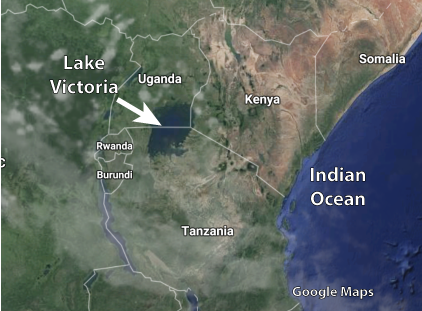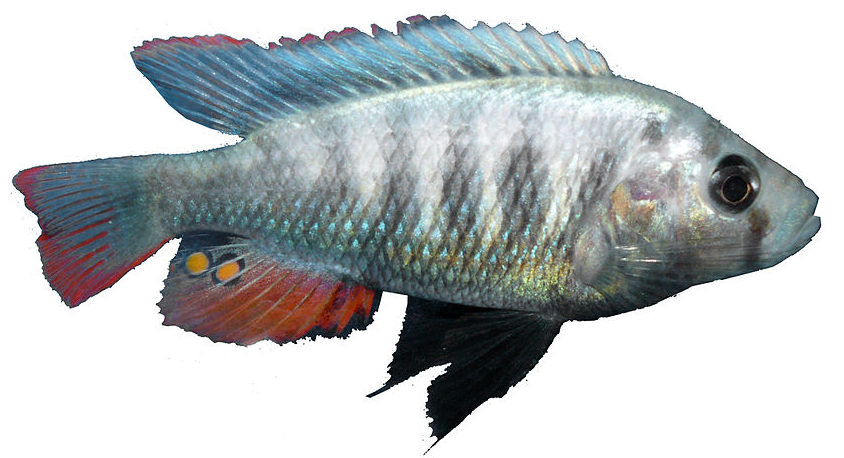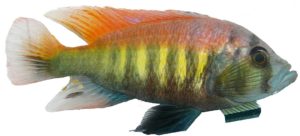1. Sympatric Speciation: Introduction
[qwiz qrecord_id=”sciencemusicvideosMeister1961-Sympatric Speciation, Introduction”]
[h]Sympatric Speciation: An Introduction
[q labels = “right”]The diagram below contrasts allopatric speciation with sympatric speciation. You already know about allopatric speciation, so use what you know to label the diagram below.
[l]allopatric
[fx] No. Please try again.
[f*] Good!
[l]sympatric
[fx] No. Please try again.
[f*] Excellent!
[q labels = “top”]_____________ speciation occurs without any ________________ barrier or separation. In other words,_______________ isolation between subgroups of a parent species has to arise while these subgroups are in the same geographical ________.
[l]area
[fx] No, that’s not correct. Please try again.
[f*] Excellent!
[l]geographical
[fx] No. Please try again.
[f*] Good!
[l]reproductive
[fx] No, that’s not correct. Please try again.
[f*] Good!
[l]sympatric
[fx] No. Please try again.
[f*] Excellent!
[q]The model below represents sympatric speciation. The key feature of this model is that the new species at “a” arises without any _____________ barrier.
[hangman]
[c]Z2VvZ3Jh cGhpY2Fs[Qq]
[/qwiz]
2. In plants, sympatric speciation can occur through polyploidy and allopolyploidy
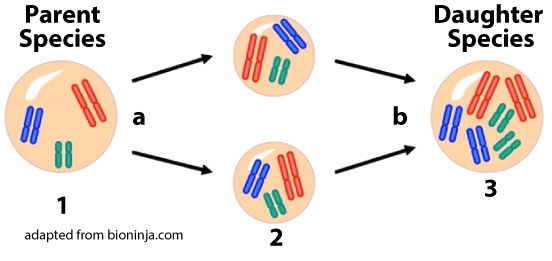
In plants and fungi (and much less frequently in animals), sympatric speciation can arise through a process called polyploidy: a doubling (or more) of chromosome number. In the diagram at left, the diploid number of an organism from the parent species is six (2n = 6, with three homologous pairs). An error during meiosis (represented by the arrow at “a”) creates gametes (2) that still have the diploid number of chromosomes, rather than a haploid set. If, as often happens in plants, these gametes self-fertilize (b), then a daughter species will be created with a diploid number of twelve (2n = 12, with six homologous pairs). If the parent and the daughter can’t hybridize (which could result from the fact that their chromosome numbers differ), then we have instant reproductive isolation and instant speciation.
A variation on polyploidy is allopolyploidy, where polyploidy is combined with hybridization, also resulting in instant speciation.
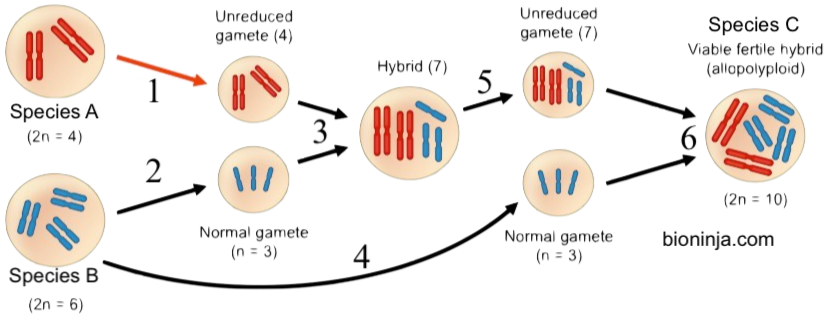
The diagram above shows how this might work. Species A (2n = 4) experiences an error in meiosis (represented by the arrow at 1), resulting in a diploid gamete. Species B produces a haploid gamete via normal meiosis (2). The gamete from species A fertilizes the gamete from species B (arrow at 3), producing a hybrid zygote with seven chromosomes. That hybrid undergoes abnormal meiosis (arrow at 5) producing a gamete that also has seven chromosomes. If that hybrid gamete gets fertilized (6) by a normal gamete from species B, then we have a new hybrid species (species C). Note that the new species has an even number of chromosomes (which is what a sexually reproducing species needs for successful meiosis).
If these sympatric speciation scenarios seem unlikely, consider this: between 30% and 80% of plant species are polyploid or allopolyploid descendants of previously existing species. This includes several varieties of domesticated plants, such as apples, bananas, wheat, cotton, potatoes, and sugar cane, as well as many non-domesticated species.(Wikipedia).
Based on karyotype analysis (click here for a review of karyotypes), polyploidy is also a common speciation mechanism in fungi. It’s rarer in animals, but does occur. For example, some fish species have up to 400 chromosomes, something that could have arisen through multiple duplications of chromosome sets.
3. Quiz: Polyploidy and Allopolyploidy
[qwiz random=”false” qrecord_id=”sciencemusicvideosMeister1961-Polyploidy and Allopolyploidy”] [h]
Sympatric Speciation through Polyploidy and Allopolyploidy
[i]
[q multiple_choice=”true”] Among the multicellular, eukaryotic kingdoms, speciation through polyploidy and allopolyploidy is least common in
[c]cGxhbnRz[Qq]
[f]Tm8uIFNwZWNpYXRpb24gdGhyb3VnaCBwb2x5cGxvaWR5IGFuZCBhbGxvcG9seXBsb2lkeSBpcyA=bW9zdA==IGNvbW1vbiBpbiBwbGFudHM=[Qq]
[c]IGFuaW 1hbHM=[Qq]
[f]WWVzISBTcGVjaWF0aW9uIHRocm91Z2ggcG9seXBsb2lkeSBhbmQgYWxsb3BvbHlwbG9pZHkgaXMgdW5jb21tb24gaW4gYW5pbWFscy4=[Qq]
[c]ZnVuZ2k=[Qq]
[f]Tm8uIFNwZWNpYXRpb24gdGhyb3VnaCBwb2x5cGxvaWR5IGFuZCBhbGxvcG9seXBsb2lkeSBpcyBkZWZpbml0ZWx5IGZvdW5kIGluIGZ1bmdpLg==[Qq]
[q] In the diagram below, which letter refers to (abnormal) meiosis?
[textentry single_char=”true”]
[c]IG E=[Qq]
[f]IE5pY2Ugam9iIQ==[Qq]
[c]IEVudGVyIHdvcmQ=[Qq]
[f]IE5vLg==[Qq]
[c]ICo=[Qq]
[f]IE5vLiBUaGlzIGRpYWdyYW0gaXMgYSBsaXR0bGUgY29uZnVzaW5nIHVubGVzcyB5b3Uga25vdyB0aGF0IGl0JiM4MjE3O3MgYWJvdXQgcG9seXBsb2lkeQ==LCBhIHByb2Nlc3MgdGhhdCBpbnZvbHZlcyBkb3VibGluZyBjaHJvbW9zb21lIG51bWJlci7CoCBJZiB0aGUgZ2FtZXRlcyBhcmUgYXQgJiM4MjIwOzIsJiM4MjIxOyB0aGVuIHdoaWNoIG51bWJlciBoYXMgdG8gcmVwcmVzZW50IG1laW9zaXM/[Qq]
[q] In the diagram below, which letter indicates fertilization?
[textentry single_char=”true”]
[c]IG I=[Qq]
[f]IEV4Y2VsbGVudCE=[Qq]
[c]IEVudGVyIHdvcmQ=[Qq]
[f]IE5vLCB0aGF0JiM4MjE3O3Mgbm90IGNvcnJlY3Qu[Qq]
[c]ICo=[Qq]
[f]IE5vLiBUaGlzIGRpYWdyYW0gaXMgYSBsaXR0bGUgY29uZnVzaW5nIHVubGVzcyB5b3Uga25vdyB0aGF0IGl0JiM4MjE3O3MgYWJvdXQgcG9seXBsb2lkeQ==LCBhIHByb2Nlc3MgdGhhdCBpbnZvbHZlcyBkb3VibGluZyBjaHJvbW9zb21lIG51bWJlci7CoCBJZiB0aGUgZ2FtZXRlcyBhcmUgYXQgJiM4MjIwOzIsJiM4MjIxOyB0aGVuIHdoaWNoIG51bWJlciBoYXMgdG8gcmVwcmVzZW50IGZlcnRpbGl6YXRpb24/[Qq]
[q] The diagram below represents speciation through [hangman].
[c]IHBvbHlwbG9pZHk=[Qq]
[f]IEdvb2Qh[Qq]
[q] Because they change chromosome number, both polyploidy and allopolyploidy can result in [hangman] speciation,
[c]IGluc3RhbnQ=[Qq]
[f]IEdyZWF0IQ==[Qq]
[q] Both polyploidy and allopolyploidy involve changes in [hangman] number.
[c]IGNocm9tb3NvbWU=[Qq]
[f]IEV4Y2VsbGVudCE=[Qq]
[q multiple_choice=”true”] The diagram below represents
[c]YWxsb3BvbH lwbG9pZHk=[Qq]
[f]IEV4Y2VsbGVudCEgVGhlIGRpYWdyYW0gYWJvdmUgc2hvd3MgYWxsb3BvbHlwbG9pZHk6IGFibm9ybWFsIG1laW9zaXMsIGZvbGxvd2VkIGJ5IGh5YnJpZGl6YXRpb24u[Qq]
[c]cG9seXBsb2lkeQ==[Qq]
[f]Tm8uIFBvbHlwbG9pZHkgaW52b2x2ZWQgc3BlY2lhdGlvbiB0aHJvdWdoIGEgZG91Ymxpbmcgb2YgY2hyb21vc29tZSBudW1iZXIuIEl0IGxvb2tzIGxpa2UgdGhpczo=
Cg==[Qq]
[q multiple_choice=”true”] Allopolyploidy starts with which of the following processes?
[c]IG1laW9zaXMgZm9sbG93ZWQgYnkgbWl0b3Npcw==[Qq]
[f]Tm8uIE1laW9zaXMgaXMgZGVmaW5pdGVseSBpbnZvbHZlZC4gQnV0IGl0JiM4MjE3O3MgZm9sbG93ZWQgYnkgYW5vdGhlciBzdGVwLiBXaGF0JiM4MjE3O3MgZ29pbmcgb24gYXQgbGluZXMgJiM4MjIwOzMmIzgyMjE7IGFuZCAmIzgyMjA7ND8mIzgyMjE7[Qq]
[c]Y2hyb21vc29tZSBkdXBsaWNhdGlvbiBmb2xsb3dlZCBieSBtZWlvc2lz[Qq]
[f]Tm8uIFBvbHlwbG9pZHkgaXMgZGVmaW5pdGVseSBpbnZvbHZlZC4gQW5kIChhYm5vcm1hbCkgbWVpb3NpcyBpbiBpbnZvbHZlZCwgdG9vLiBCdXQgdGhlcmUmIzgyMTc7cyBhbm90aGVyIGltcG9ydGFudCBzdGVwLiBXaGF0JiM4MjE3O3MgZ29pbmcgb24gYXQgbGluZXMgJiM4MjIwOzMmIzgyMjE7IGFuZCAmIzgyMjA7ND8mIzgyMjE7[Qq]
[c]Y2hyb21vc29tZSBkdXBsaWNhdGlvbiBm b2xsb3dlZCBieSBoeWJyaWRpemF0aW9u[Qq]
[f]Q29ycmVjdC4gRm9yIGFsbG9wb2x5cGxvaWR5LCB5b3UgbmVlZCBwb2x5cGxvaWR5LCBmb2xsb3dlZCBieSBoeWJyaWRpemF0aW9uIChmb2xsb3dlZCBieSBtb3JlIG1laW9zaXMgYW5kIGh5YnJpZGl6YXRpb24pLg==[Qq]
[q multiple_choice=”true”] In the diagram below, which number represents abnormal meiosis?
[c]ID Eg[Qq][c]IDIg[Qq][c]IDMg[Qq][c]IDQ=
Cg==[Qq][f]IEV4Y2VsbGVudC4gJiM4MjIwOzEmIzgyMjE7IHNob3dzIG1laW9zaXMgdGhhdCYjODIxNztzIG5vdCByZWR1Y2luZyBjaHJvbW9zb21lcyBudW1iZXIgZnJvbSBkaXBsb2lkIHRvIGhhcGxvaWQu[Qq]
[f]IE5vLiAmIzgyMjA7MiYjODIyMTsgc2hvd3Mgbm9ybWFsIG1laW9zaXMsIHdoZXJlIGNocm9tb3NvbWUgbnVtYmVyIGlzIGJlaW5nIHJlZHVjZWQgZnJvbSBoYXBsb2lkIHRvIGRpcGxvaWQuwqBGaW5kIG1laW9zaXMgd2hlcmUgdGhhdCYjODIxNztzIG5vdCBoYXBwZW5pbmcsIGFuZCB5b3UmIzgyMTc7bGwgaGF2ZSB5b3VyIGFuc3dlci4=[Qq]
[f]IE5vLiAmIzgyMjA7MyYjODIyMTsgaXMgc2hvd2luZyBmZXJ0aWxpemF0aW9uLiBGaW5kIGFuIGFycm93IHRoYXQgcmVwcmVzZW50cyBtZWlvc2lzLCBhbmQgeW91JiM4MjE3O2xsIGJlIG9uIHRoZSByaWdodCB0cmFjay4=[Qq]
[f]IE5vLiAmIzgyMjA7NCYjODIyMTsgaXMgc2hvd2luZyBub3JtYWwgbWVpb3Npcywgd2l0aCBjaHJvbW9zb21lIG51bWJlciBnb2luZyBmcm9tIGhhcGxvaWQgdG8gZGlwbG9pZC4gRmluZCBtZWlvc2lzIHdoZXJlIHRoYXQmIzgyMTc7cyBub3QgaGFwcGVuaW5nLCBhbmQgeW91JiM4MjE3O2xsIGhhdmUgeW91ciBhbnN3ZXIu[Qq]
[q multiple_choice=”true”] In the diagram below, which number represents fertilization?
[c]IDEg[Qq][c]IDIg[Qq][c]IDUg[Qq][c]ID Y=
Cg==[Qq][f]IE5vLiAmIzgyMjA7MSYjODIyMTsgcmVwcmVzZW50cyBhYm5vcm1hbCBtZWlvc2lzIChpbiB3aGljaCBjaHJvbW9zb21lIG51bWJlciBpcyBub3QgYmVpbmcgcmVkdWNlZCBmcm9tIGRpcGxvaWQgdG8gaGFwbG9pZC4gRmluZCBhIG51bWJlciB0aGF0IHJlcHJlc2VudHMgZ2FtZXRlcyBjb21pbmcgdG9nZXRoZXIu[Qq]
[f]IE5vLiAmIzgyMjA7MiYjODIyMTsgc2hvd3Mgbm9ybWFsIG1laW9zaXMuIEZpbmQgYSBudW1iZXIgdGhhdCByZXByZXNlbnRzIGdhbWV0ZXMgZnVzaW5nIHRvZ2V0aGVyLg==[Qq]
[f]IE5vLiAmIzgyMjA7NSYjODIyMTsgaXMgc2hvd2luZyBhYm5vcm1hbCBtZWlvc2lzLCBpbiB3aGljaCBjaHJvbW9zb21lIG51bWJlciBpcyBub3QgYmVpbmcgcmVkdWNlZC4gRmluZCBhIG51bWJlciB3aGVyZSBnYW1ldGVzIGFyZSBmdXNpbmcgdG9nZXRoZXIu[Qq]
[f]IEZhYnVsb3VzLiAmIzgyMjA7NiYjODIyMTsgaXMgc2hvd2luZyBmZXJ0aWxpemF0aW9uICh0aGUgb25lIHRoYXQgY3JlYXRlcyB0aGUgbmV3LCBhbGxvcG9seXBsb2lkIHNwZWNpZXMuKQ==[Qq]
[/qwiz]
4. Sympatric Speciation in Animals
4a. Sexual Selection
Sympatric speciation happens in animals too, but rarely by the kind of instant changes in chromosome number described above. A more common mechanism for sympatric speciation in animals is sexual selection (click the link to go to a tutorial).
|
|
|
|
The cichlids of Lake Victoria are a well-studied example of how sexual selection can lead to sympatric speciation. Lake Victoria borders on Uganda, Kenya, and Tanzania. With a surface area of almost 68,800 square kilometers (26,600 square miles), it’s the world’s second largest freshwater lake, second only to North America’s Lake Superior.
Lake Victoria is home to hundreds of species of a type of fish called a cichlid, two of which are shown above. Cichlids are relatively small fish: P. pundamilia’s maximum length is about 12 cm. P. nyererei can grow to be about 8 cm long.
While there is some habitat differentiation within the lake (deeper water, shallower water, sandbars, papyrus reeds, etc.) the lake has no internal barriers. In other words, allopatric speciation isn’t possible. That leads to two questions:
- How did 500 speciation events occur among Lake Victoria cichlids?
- What prevented gene flow between cichlid populations as speciation was occurring (and what maintains it now between all these closely-related species)?
Based on observations of Cichlid behavior in the wild, and a variety of laboratory experiments, it seems that female mate choice is a major factor in keeping the gene pools of the hundreds of Lake Victoria cichlid species separate.
Here are two things to know.
- In terms of color, there’s a lot of sexual dimorphism between male and female cichlids.
Male P. nyererei Female P. nyererei 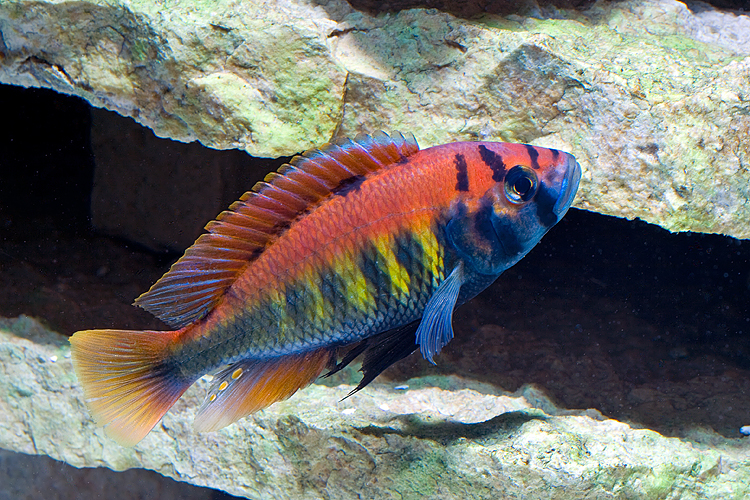
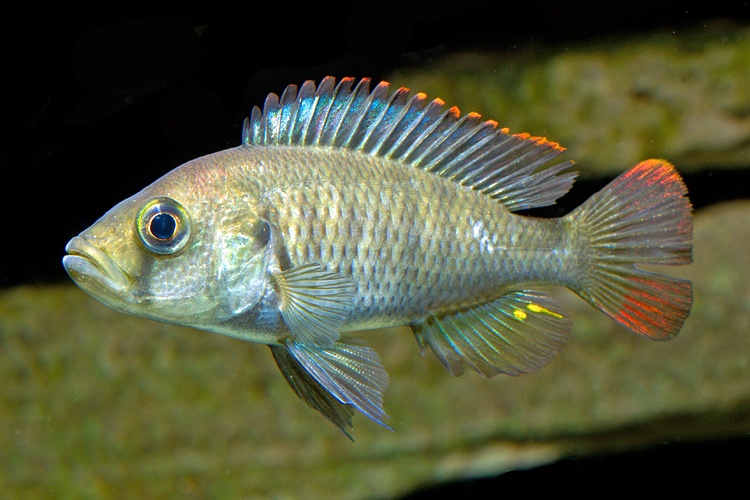
- Female cichlids only lay eggs after being courted by males. In other words, the females get to choose whom they mate with.
Knowing that, answer the question below.
[qwiz]
[h]Female choice as a reproductive barrier in Cichlids
[q]Take a moment to examine the image below.
If female mate choice is at work, where do you expect there’d be more hybridization?
[c]RW52aXJvbm1lbnQgMSAo Y2xvdWR5IHdhdGVyKQ==[Qq]
[c]RW52aXJvbm1lbnQgMiAoY2xlYXIgd2F0ZXIp[Qq]
[f]RXhjZWxsZW50LiBDbG91ZHkgd2F0ZXIgbWFrZXMgaXQgbW9yZSBkaWZmaWN1bHQgdG8gZGlzdGluZ3Vpc2ggYmV0d2VlbiB0aGUgYmx1ZXIgUC4gcHVuZGFtaWxpYcKgYW5kIHRoZSByZWRkZXIgUC4gbnllcmVyZWkuwqA=QXMgYSByZXN1bHQsIGZlbWFsZXMgY2FuJiM4MjE3O3QgZWFzaWx5IGNob29zZSBtYWxlcyBvZiB0aGVpciBvd24gc3BlY2llcywgYW5kIG1vcmUgaHlicmlkaXphdGlvbiBvY2N1cnMu[Qq]
[f]Tm8uwqBDbG91ZHkgd2F0ZXIgbWFrZXMgaXQgbW9yZSBkaWZmaWN1bHQgdG8gZGlzdGluZ3Vpc2ggYmV0d2VlbiB0aGUgYmx1ZXIgUC4gcHVuZGFtaWxpYcKgYW5kIHRoZSByZWRkZXIgUC4gbnllcmVyZWkuwqA=QXMgYSByZXN1bHQsIGZlbWFsZXMgY2FuJiM4MjE3O3QgZWFzaWx5IGNob29zZSBtYWxlcyBvZiB0aGVpciBvd24gc3BlY2llcywgYW5kIG1vcmUgaHlicmlkaXphdGlvbiBvY2N1cnMu
[Qq]Main source: Philosophical Transactions of The Royal Society B Biological Sciences 363(1505):2871-7 · June 2008
[/qwiz]
In other words, if females can’t discriminate between males, the reproductive boundaries between closely related species will start to break down. These results in the field were confirmed by experiments by researchers O. Seehausen and J.J. M. van Alphen. In a series of mate choice experiments, Seehausen and Alphen showed that when Pundamilia females were exposed to males illuminated by monochromatic light (light of one wavelength, which made it impossible for the females to differentiate between color patterns on the males’ scales), the females mated indiscriminately with males from either species. The hybrids were both viable and fertile. (Source: Campbell, Biology, 11th edition; also Female mating preference functions predict sexual selection against hybrids between sibling species of cichlid fish.).
What’s the takeaway? Without female choice, genetic barriers between cichlid species would collapse. Reproductive barriers between populations can arise from and be maintained by sexual selection.
4b. Disruptive Selection
A second cause of sympatric speciation in animals (and plants) is disruptive (or diversifying) selection. Disruptive selection involves selection for extreme phenotypes (for example, the lightest and darkest or shortest and tallest individuals in a population), and against intermediate phenotypes.
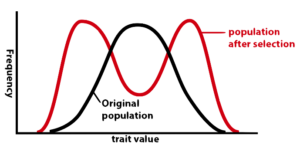
Imagine, for example, a species of mouse that lives in an environment with both dark and light areas. The mouse is preyed upon by a visual predator, such as a hawk. In this context, mice with white fur and mice with dark fur will have an advantage, while gray mice would be at a disadvantage. Over time, there will be selection for light and dark, and against gray. Assuming that coloration is under genetic control, predators in the environment will be selecting for true-breeding strains of light and dark mice. It’s thought that this type of selection, continued over many generations, could lead to speciation.
4c. Habitat Differentiation
A third mechanism underlying sympatric speciation is habitat differentiation.
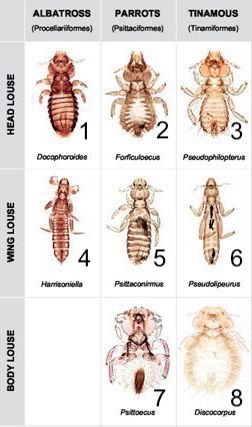
The table to the left shows eight different species of bird lice. Bird lice are parasitic insects that feed on bird feathers, scales, or blood. Speciation in these lice has two dimensions:
1) Different types of birds are parasitized by different species of lice (with some lice species parasitizing albatrosses, others parrots etc.).
2) Different species of lice specialize on different parts of the birds. In other words, there’s one species of louse that’s adapted for life on the head of albatrosses, and a separate species adapted for life on albatrosses’ wings. Parrots (and other types of birds) similarly have their own uniquely adapted head, wing and body lice.
How could such speciation arise? Imagine the ancestors of today’s bird-lice, tens of millions of years ago. These parasites might have already parasitized the small dinosaurs that were the ancestors of birds. As birds differentiated into different species, each living in different habitats, nesting in different areas, and more or less prevalent in different geographical areas, the lice on each species of bird would find their gene pools to be largely cut off from the bird-lice that were parasitizing other bird species. Genetic drift and natural selection would cause the bird-lice parasitizing these different bird species to genetically differentiate, evolving into separate species. Note that while these emerging species were on different types of birds, there was never any geographical barrier (so we can’t think of this as allopatric speciation).
Now think about each bird. The bird lice that parasitized albatrosses spread over the albatross’s body, some living on the albatross’s heads, some on their wings, and so on. The adaptations required for hiding, feeding, and holding on to the head were different from the adaptations required for hiding, feeding, and holding on to the wings. So, on each bird, there’s disruptive selection. Over time, the albatross head-lice become reproductively isolated from the albatross wing-lice.
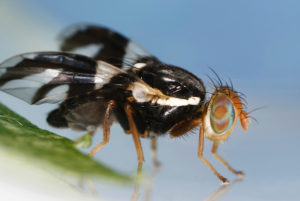
Another example of sympatric speciation through habitat differentiation that has occurred within the last few hundred years has involved the apple maggot fly, Rhagoletis pomonella. This species is native to North America, where it breeds in the fruit of Hawthorn trees. Females lay their eggs on Hawthorn fruit. The eggs develop into maggots, which consume the fruit as they grow.

Apples and hawthorns are both in the same botanical family, Rosaceae. When European colonists introduced domesticated apples into North America in the 1600s, it didn’t take long for Rhagoletis to jump from its original host to the newly introduced apples. By the mid 1800s, Rhagoletis was causing crop losses in apple orchards, and it continues to be a major agricultural nuisance to this day.
Those Rhagoletis populations that parasitize apples seem to be heading down a road that will result in their forming a new species. For one thing, Rhagoletis flies lay their eggs on the same type of fruit where they themselves developed, which creates a habitat barrier, reducing gene flow between the hawthorn and apple populations. In addition, hawthorns and apples produce fruit at different times of the year, with apples producing fruit in mid-July, and hawthorns producing fruit in mid-September. This creates a temporal barrier between the two populations, further reducing gene flow. In addition, a recent study has uncovered differences in smell preferences in each sub-group, with Hawthorn-infesting flies preferring the smell of hawthorns, and apple-infesting flies preferring the smell of apples, providing a behavioral and neurological basis for further differentiation. Click here to read a study about smell preferences, and here for a more general overview of Rhagoletis evolution.
5. Sympatric Speciation: Checking Understanding
In this tutorial, you’ve learned that speciation can occur sympatrically: without a geographic barrier. Test your mastery by answering the questions below.
[qwiz qrecord_id=”sciencemusicvideosMeister1961-Sympatric Speciation, CFU”]
[h]Sympatric Speciation: Checking Understanding
[i]
[q]_________ speciation occurs without a geographic barrier.
[hangman]
[c]c3ltcGF0cmlj[Qq]
[q]____________ is a process that involves the duplication of entire chromosome sets.
[hangman]
[c]cG9seXBsb2lkeQ==[Qq]
[q]____________ is a process that involves an increase in chromosome number combined with hybridization.
[hangman]
[c]YWxsb3BvbHlwbG9pZHk=[Qq]
[q]Of the multicellular eukaryotic kingdoms, the one with the least amount of speciation through polyploidy or allopolyploidy is the ____________ kingdom.
[hangman]
[c]YW5pbWFs[Qq]
[q]The type of speciation represented below is
[hangman]
[c]cG9seXBsb2lkeQ==[Qq]
[q]The type of speciation represented below is
[hangman]
[c]YWxsb3BvbHlwbG9pZHk=[Qq]
[q]As represented by the diagram below, the fact that more hybridization occurs in environment 1 than environment 2 seems to be evidence for [hangman] selection acting as a reproductive barrier between Cichlid species.
[c]c2V4dWFs[Qq]
[q]In any model of sympatric speciation, a key thing to explain is what’s preventing _______ flow between emerging species.
[hangman]
[c]Z2VuZQ==[Qq]
[q]The diagram below shows the effect of [hangman] selection.
[c]ZGlzcnVwdGl2ZQ==[Qq]
[q multiple_choice=”true”]Disruptive selection could lead to speciation by eliminating __________ genotypes (and phenotypes) within a population.
[c]aG9tb3p5Z291cw==[Qq]
[f]Tm8uIERpc3J1cHRpdmUgc2VsZWN0aW9uIGlzIHNlbGVjdGlvbiBhZ2FpbnN0IGludGVybWVkaWF0ZSBwaGVub3R5cGVzLiBIb21venlnb3VzIHBoZW5vdHlwZXMgd291bGRuJiM4MjE3O3QgYmUgaW50ZXJtZWRpYXRlLiBIaW50OiB3aGF0IHdvcmQgbWVhbnMgJiM4MjIwO2EgY29tYmluYXRpb24gb2YgYm90aD8mIzgyMjE7[Qq]
[c]aHli cmlk[Qq]
[f]TmljZS4gRGlzcnVwdGl2ZSBzZWxlY3Rpb24gd291bGQgc2VsZWN0IGFnYWluc3QgaW50ZXJtZWRpYXRlIHBoZW5vdHlwZXM=[Qq]
[c]ZG9taW5hbnQ=[Qq]
[f]Tm8uIFdoYXQgZ2V0cyBzZWxlY3RlZCBieSBuYXR1cmFsIHNlbGVjdGlvbiBpcyByZWxhdGVkIHRvIGhvdyB3ZWxsLWFkYXB0ZWQgYSBwaGVub3R5cGUgaXMuIFRoZXJlJiM4MjE3O3Mgbm8gY29ubmVjdGlvbiBiZXR3ZWVuIHRoYXQgYW5kIGFuIGFsbGVsZSBiZWluZyBkb21pbmFudCBvciByZWNlc3NpdmUu[Qq]
[c]cmVjZXNzaXZl[Qq]
[f]Tm8uIFdoYXQgZ2V0cyBzZWxlY3RlZCBieSBuYXR1cmFsIHNlbGVjdGlvbiBpcyByZWxhdGVkIHRvIGhvdyB3ZWxsLWFkYXB0ZWQgYSBwaGVub3R5cGUgaXMuIFRoZXJlJiM4MjE3O3Mgbm8gY29ubmVjdGlvbiBiZXR3ZWVuIHRoYXQgYW5kIGFuIGFsbGVsZSBiZWluZyBkb21pbmFudCBvciByZWNlc3NpdmUu[Qq]
[q]Bird lice and apple maggot flies are both examples of sympatric speciation through [hangman] differentiation
[c]aGFiaXRhdA==[Qq]
[q]Rhagoletis flies infesting hawthorns have to breed later in the year than Rhagoletis flies infesting apples. This is an example of a __________ barrier.
[hangman]
[c]dGVtcG9yYWw=[Qq]
[/qwiz]
Links

